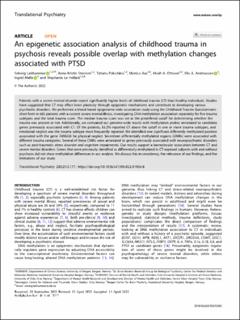| dc.contributor.author | Løkhammer, Solveig | |
| dc.contributor.author | Stavrum, Anne-Kristin Støbakk | |
| dc.contributor.author | Polushina, Tatiana | |
| dc.contributor.author | Aas, Monica | |
| dc.contributor.author | Ottesen, Akiah | |
| dc.contributor.author | Andreassen, Ole | |
| dc.contributor.author | Melle, Ingrid | |
| dc.contributor.author | Hellard, Stephanie Francoise Claire Le | |
| dc.date.accessioned | 2022-06-01T12:15:15Z | |
| dc.date.available | 2022-06-01T12:15:15Z | |
| dc.date.created | 2022-05-03T15:40:47Z | |
| dc.date.issued | 2022 | |
| dc.identifier.issn | 2158-3188 | |
| dc.identifier.uri | https://hdl.handle.net/11250/2997235 | |
| dc.description.abstract | Patients with a severe mental disorder report significantly higher levels of childhood trauma (CT) than healthy individuals. Studies have suggested that CT may affect brain plasticity through epigenetic mechanisms and contribute to developing various psychiatric disorders. We performed a blood-based epigenome-wide association study using the Childhood Trauma Questionnaire-short form in 602 patients with a current severe mental illness, investigating DNA methylation association separately for five trauma subtypes and the total trauma score. The median trauma score was set as the predefined cutoff for determining whether the trauma was present or not. Additionally, we compared our genome-wide results with methylation probes annotated to candidate genes previously associated with CT. Of the patients, 83.2% reported CT above the cutoff in one or more trauma subtypes, and emotional neglect was the trauma subtype most frequently reported. We identified one significant differently methylated position associated with the gene TANGO6 for physical neglect. Seventeen differentially methylated regions (DMRs) were associated with different trauma categories. Several of these DMRs were annotated to genes previously associated with neuropsychiatric disorders such as post-traumatic stress disorder and cognitive impairments. Our results support a biomolecular association between CT and severe mental disorders. Genes that were previously identified as differentially methylated in CT-exposed subjects with and without psychosis did not show methylation differences in our analysis. We discuss this inconsistency, the relevance of our findings, and the limitations of our study. | en_US |
| dc.language.iso | eng | en_US |
| dc.publisher | Nature Research | en_US |
| dc.rights | Navngivelse 4.0 Internasjonal | * |
| dc.rights.uri | http://creativecommons.org/licenses/by/4.0/deed.no | * |
| dc.title | An epigenetic association analysis of childhood trauma in psychosis reveals possible overlap with methylation changes associated with PTSD | en_US |
| dc.title.alternative | An epigenetic association analysis of childhood trauma in psychosis reveals possible overlap with methylation changes associated with PTSD | en_US |
| dc.type | Journal article | en_US |
| dc.type | Peer reviewed | en_US |
| dc.description.version | publishedVersion | en_US |
| dc.rights.holder | Copyright The Author(s) 2022 | en_US |
| dc.source.articlenumber | 177 | en_US |
| cristin.ispublished | true | |
| cristin.fulltext | original | |
| cristin.qualitycode | 1 | |
| dc.identifier.doi | 10.1038/s41398-022-01936-8 | |
| dc.identifier.cristin | 2021113 | |
| dc.source.journal | Translational Psychiatry | en_US |
| dc.identifier.citation | Translational Psychiatry. 2022, 12, 177. | en_US |
| dc.source.volume | 12 | en_US |

